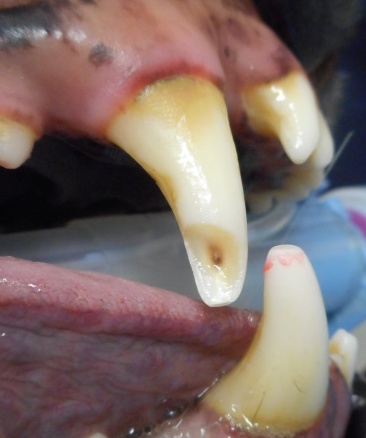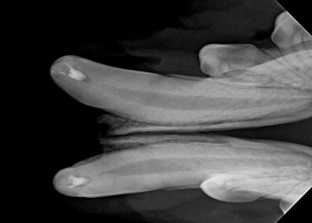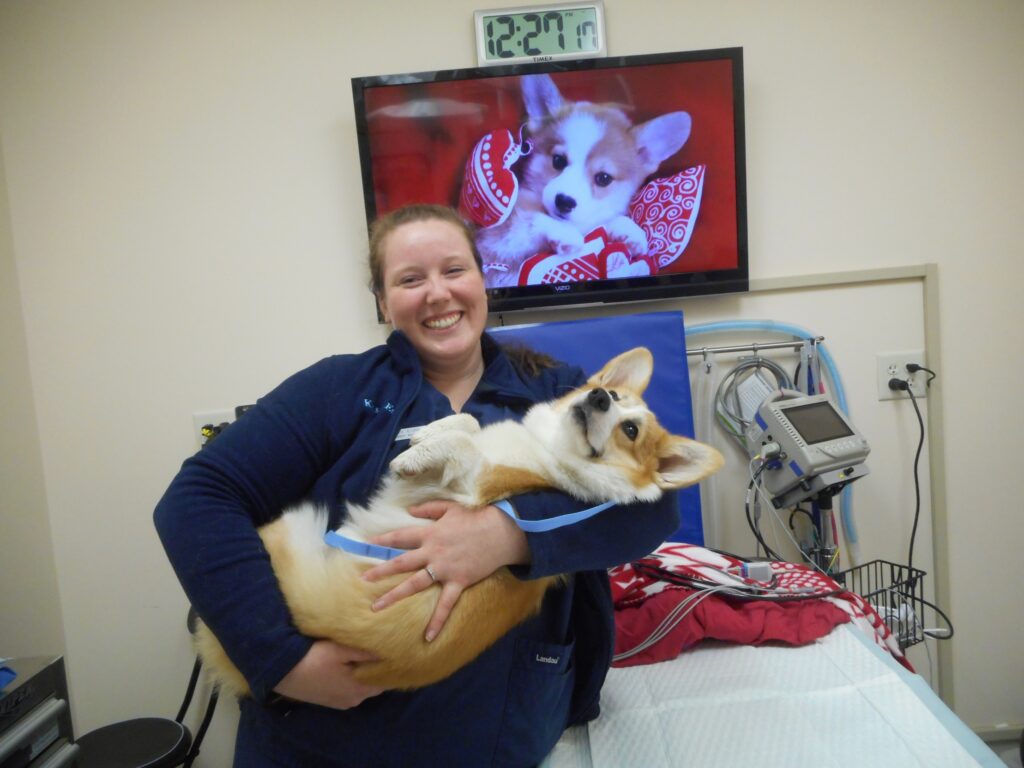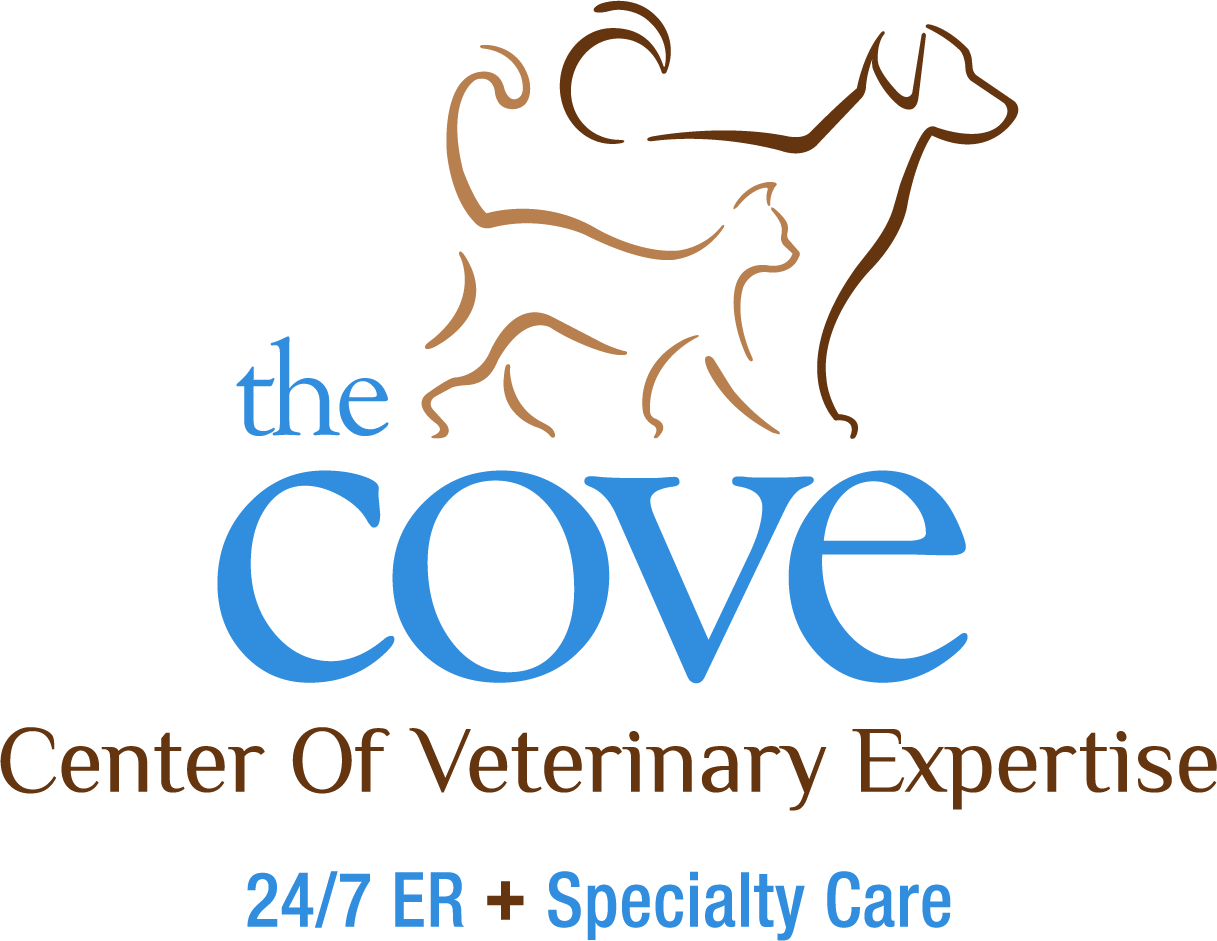Written By: Taylor Redmond, LVT
Broken teeth are very common in pets and can result from trauma or from chewing on hard objects.
If your pet has a broken or injured tooth, it is important to seek medical care immediately, either with your primary care veterinarian or here at The COVE with our highly trained and experienced dentistry department team, led by Colleen Fox, DVM, Practice Limited To Dentistry.
The most common teeth to break in cats and dogs are the maxillary fourth premolars and the canines. Premolars usually break on hard chew toys, including antlers, marrow bones, nylon bones, cow hooves, and even ice. If a toy is harder than your fingernail, it is too hard for teeth. Avoid a broken tooth and please do not give your dog a hard chew toy or bone.
How We Fix a Broken Tooth
Before any dental procedure, we will schedule a consultation for a comprehensive examination of your pet’s mouth to determine the next steps.
During the consultation with Dr. Fox, we will obtain a full history, including health conditions, current medications, dental history, and when/how the fracture occurred. One of our licensed veterinary technicians (LVTs) will get “vitals” (temperature, pulse, and respiration) and then Dr. Fox will perform an oral exam. A personalized treatment plan will be provided based on the best options for your pet, along with a detailed estimate of any costs associated with care.

Procedures to Repair a Broken Tooth
There are three procedures that can be performed on a fractured tooth with pulp exposure (the pulp tissue in the tooth is exposed to the oral environment, which can cause it to become infected and inflamed).
- Root canal therapy
- Vital pulpotomy
- Extraction
A root canal is performed to preserve the function of a tooth. During this procedure, we remove the blood and nerve supply of the tooth and replace it with an inert material called gutta-percha. A sealant is placed over the access hole to prevent bacteria from entering the pulp chamber. At The COVE, we require radiographs one year after the procedure to make sure the root canal was successful. Root canals have a 95% success rate, and, most of the time, the pet does not have any more complications with that tooth.
Crown preparation and placement can also be discussed along with root canal therapy. This does require a second anesthetic event to place the crown after it is made at an outside lab (about three weeks later), and at an additional cost. This is a good option to consider if your pet is at a higher risk of fracturing the same tooth again.
A vital pulpotomy is often performed in lieu of a root canal if a pet is young. Puppies and kittens under 18 months cannot undergo a root canal because their teeth are still young and not fully formed. However, a vital pulpotomy helps preserve the function of the broken tooth and allows the tooth to fully develop and mature which makes the tooth stronger. A vital pulpotomy is performed by only removing the infected portion of the pulp (nerve and blood supply) and then inserting a material that stimulates the tooth to make its own “band-aid” over time called a dentin bridge. It is crucial to have follow-up radiographs performed to ensure that the tooth is developing appropriately. The success rate in a vital pulpotomy is slightly lower than a root canal at 75%. However, with follow-ups with our dental department and primary care veterinarians, most pets continue to have a healthy and functioning tooth.

Extraction is the last option recommended for a fractured tooth with pulp exposure. We perform extractions on fractured teeth if radiographs show signs that a root canal may not be successful, such as tooth resorption or a broken root. This is a much shorter procedure than a root canal or vital pulpotomy, but the procedure does remove the entire tooth. After a successful extraction, follow-up radiographs are not required, but it is essential to schedule annual dental exams to keep your pet’s teeth and mouth healthy.
Treating the Mouth as a Whole
To fully assess which option is best and to assess the other teeth in the mouth, full mouth intra-oral dental radiographs and charting of each tooth is done under anesthesia immediately prior to Dr. Fox performing the procedure. We also scale and polish to help preserve the health of the other teeth.
Anesthesia Is Used for Your Pet’s Safety
General anesthesia makes it possible to perform the above dental procedures, but also allows us to perform exams and x-rays with less stress and pain for your pet. While a patient is under anesthesia, they are closely monitored by one of our LVTs. Throughout the procedure, we always keep a close eye the patient’s heart rate, blood pressure, respiratory rate, temperature, end-tidal CO2, and oxygen saturation.

Aftercare and Recovery
Aftercare for an extraction includes a diet of soft food only, for two weeks while the mouth heals. For pets that undergo a root canal and/or vital pulpotomy, they can go back to dry kibble immediately after either procedure.
We believe that the best way to ensure your pet’s recovery and overall oral health is to educate you, the pet owner. This is why we provide each pet patient and their family with a “Home Care Kit” after every dental procedure. The Kit includes the Veterinary Oral Health Council (VOHC) approved products list, a toothbrush, a sample of toothpaste, and multiple edible dental samples.
If your cat or dog breaks a tooth, it can be a frightening experience for both the pet and their family. However, if you seek medical care quickly, there is a chance that the tooth can be saved or at least extracted quickly without causing additional pain. We hope that your pet never experiences a broken tooth or any other medical emergency, but, if they do, remember, The COVE is here 24/7 for you and your furry loved ones.
Is Your Pet in Need of Advanced Dental Care?
Dr. Fox is dedicated to educating pet owners about the importance of good oral health in a compassionate and calm manner. She accepts patients via referral from primary care veterinarians. Please call 757.935.9111 for more information or to schedule an appointment.
About Us
The COVE’s veterinarians and staff wholeheartedly embrace the core values of community, collaboration, commitment, compassion, and integrity. This focus ensures that pets, the people who love them, and their primary care veterinarians have as positive and affirming a healthcare experience as possible, regardless of the circumstances that bring us all together.
